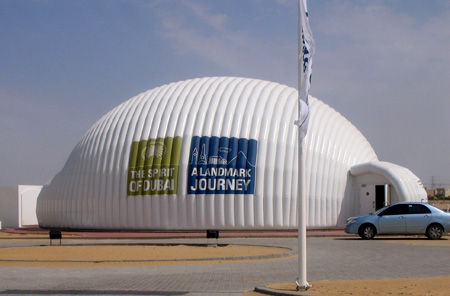Inflatable building
Inflatable buildings are constructed using two layers of membrane connected together to form inflatable 'cushions'. Membranes are usually less than 1 mm thick, and air is used to pressurise the cavity between them to form a 'rigid', structurally stable element, capable of spanning large distances.
Inflatable buildings differ from air-supported buildings, which are formed by a single-layer membrane that is supported by pressurisation of the whole interior of the building. An air-supported building prevents air from being lost when access points are opened by using airlocks, which maintain the level of air pressure inside the occupied space. Inflatable buildings have a lower power requirement than inflatable buildings as they require a lower volume of pressurised air.
Inflatable buildings are typically used for warehouses and other storage facilities, sports facilities, stadia, shopping centres and so on. Since the amount of material used for inflatable buildings is relatively low, they can be portable, with the air allowed to escape before the membrane is packed down to a small volume.
Inflatable structures (or inflatables) can also be used to create specific components such as; escape slides, mattresses, swimming and paddling pools, play slides, bouncy castles, and so on.
Legal requirements apply to the supply, hire and use of inflatable play equipment for commercial purposes, but not to private, domestic buyers and users. Inflatables can be dangerous in terms of user injuries as well as being unsuitable in high winds if inadequately secured.
Inflatables should be checked before buying or hiring for an event to ensure they comply with BS EN 14960. A label should provide information about when the inflatable was made, how many people can use it and their maximum heights. Once the inflatable is fully inflated, it should be inspected prior to use to check that the site is suitable, that the anchorages are secure, and the internal air pressure provides a firm footing.
[edit] Related articles on Designing Buildings Wiki
Featured articles and news
The benefits of engaging with insulation manufacturers
When considering ground floor constructions.
Lighting Industry endorses Blueprint for Electrification
The Lighting Industry Association fully supports the ECA Blueprint as a timely, urgent call to action.
BSRIA Sentinel Clerk of Works Training Case Study
Strengthening expertise to enhance service delivery with integrated cutting-edge industry knowledge.
Impact report from the Supply Chain Sustainability School
Free sustainability skills, training and support delivered to thousands of UK companies to help cut carbon.
The Building Safety Forum at the Installershow 2025
With speakers confirmed for 24 June as part of Building Safety Week.
The UK’s largest air pollution campaign.
Future Homes Standard, now includes solar, but what else?
Will the new standard, due to in the Autumn, go far enough in terms of performance ?
BSRIA Briefing: Cleaner Air, Better tomorrow
A look back at issues relating to inside and outside air quality, discussed during the BSRIA briefing in 2023.
Restoring Abbotsford's hothouse
Bringing the writer Walter Scott's garden to life.
Reflections on the spending review with CIAT.
Retired firefighter cycles world to raise Grenfell funds
Leaving on 14 June 2025 Stephen will raise money for youth and schools through the Grenfell Foundation.
Key points for construction at a glance with industry reactions.
Functionality, visibility and sustainability
The simpler approach to specification.
Architects, architecture, buildings, and inspiration in film
The close ties between makers and the movies, with our long list of suggested viewing.
SELECT three-point plan for action issued to MSPs
Call for Scottish regulation, green skills and recognition of electrotechnical industry as part of a manifesto for Scottish Parliamentary elections.
UCEM becomes the University of the Built Environment
Major milestone in its 106-year history, follows recent merger with London School of Architecture (LSE).
Professional practical experience for Architects in training
The long process to transform the nature of education and professional practical experience in the Architecture profession following recent reports.























